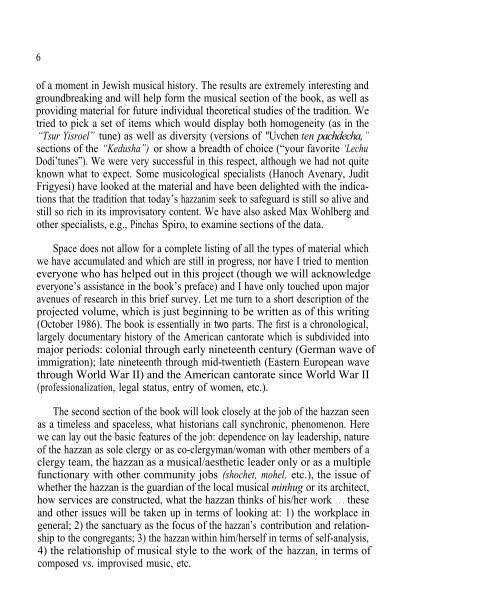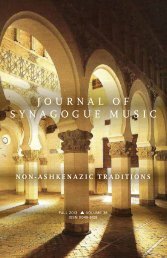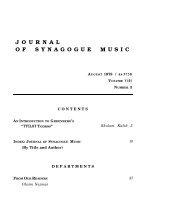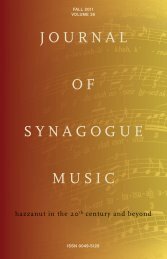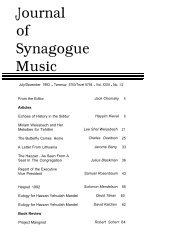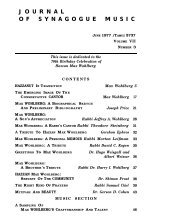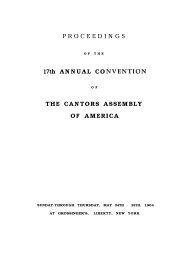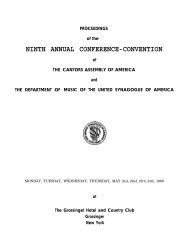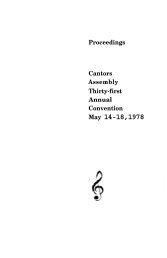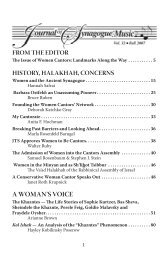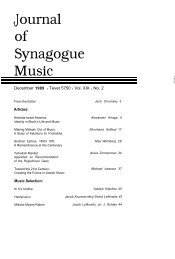Volume 16, Number 2 - Cantors Assembly
Volume 16, Number 2 - Cantors Assembly
Volume 16, Number 2 - Cantors Assembly
Create successful ePaper yourself
Turn your PDF publications into a flip-book with our unique Google optimized e-Paper software.
6<br />
of a moment in Jewish musical history. The results are extremely interesting and<br />
groundbreaking and will help form the musical section of the book, as well as<br />
providing material for future individual theoretical studies of the tradition. We<br />
tried to pick a set of items which would display both homogeneity (as in the<br />
“Tsur Yisroel” tune) as well as diversity (versions of "Uvchen ten pachdecha, ”<br />
sections of the “Kedusha”) or show a breadth of choice (“your favorite ‘Lechu<br />
Dodi’tunes”). We were very successful in this respect, although we had not quite<br />
known what to expect. Some musicological specialists (Hanoch Avenary, Judit<br />
Frigyesi) have looked at the material and have been delighted with the indications<br />
that the tradition that today’s hazzanim seek to safeguard is still so alive and<br />
still so rich in its improvisatory content. We have also asked Max Wohlberg and<br />
other specialists, e.g., Pinchas Spiro, to examine sections of the data.<br />
Space does not allow for a complete listing of all the types of material which<br />
we have accumulated and which are still in progress, nor have I tried to mention<br />
everyone who has helped out in this project (though we will acknowledge<br />
everyone’s assistance in the book’s preface) and I have only touched upon major<br />
avenues of research in this brief survey. Let me turn to a short description of the<br />
projected volume, which is just beginning to be written as of this writing<br />
(October 1986). The book is essentially in two parts. The first is a chronological,<br />
largely documentary history of the American cantorate which is subdivided into<br />
major periods: colonial through early nineteenth century (German wave of<br />
immigration); late nineteenth through mid-twentieth (Eastern European wave<br />
through World War II) and the American cantorate since World War II<br />
(professionalization, legal status, entry of women, etc.).<br />
The second section of the book will look closely at the job of the hazzan seen<br />
as a timeless and spaceless, what historians call synchronic, phenomenon. Here<br />
we can lay out the basic features of the job: dependence on lay leadership, nature<br />
of the hazzan as sole clergy or as co-clergyman/woman with other members of a<br />
clergy team, the hazzan as a musical/aesthetic leader only or as a multiple<br />
functionary with other community jobs (shochet, mohel, etc.), the issue of<br />
whether the hazzan is the guardian of the local musical minhug or its architect,<br />
how services are constructed, what the hazzan thinks of his/her work . . . these<br />
and other issues will be taken up in terms of looking at: 1) the workplace in<br />
general; 2) the sanctuary as the focus of the hazzan’s contribution and relationship<br />
to the congregants; 3) the hazzan within him/herself in terms of self-analysis,<br />
4) the relationship of musical style to the work of the hazzan, in terms of<br />
composed vs. improvised music, etc.


